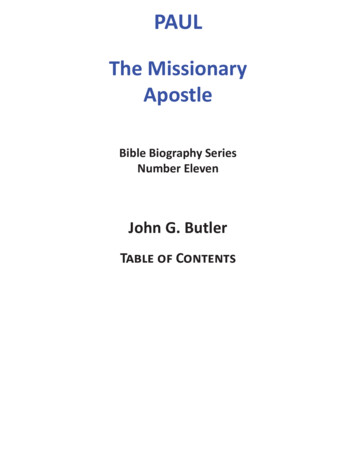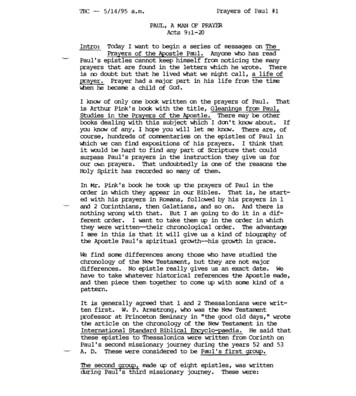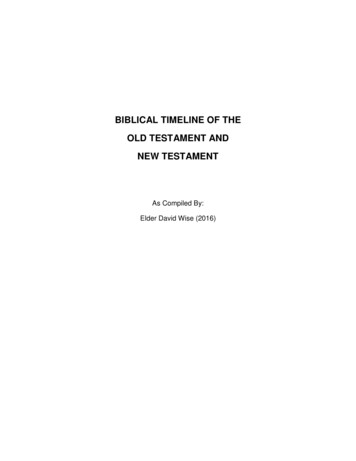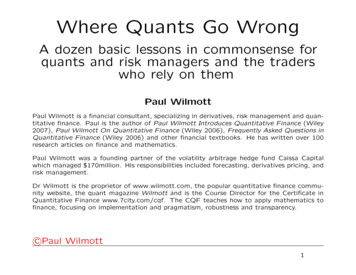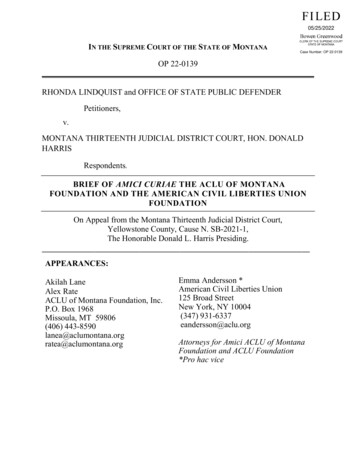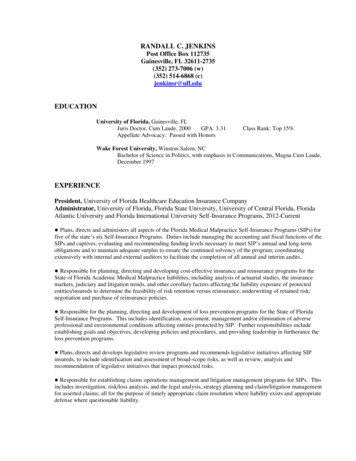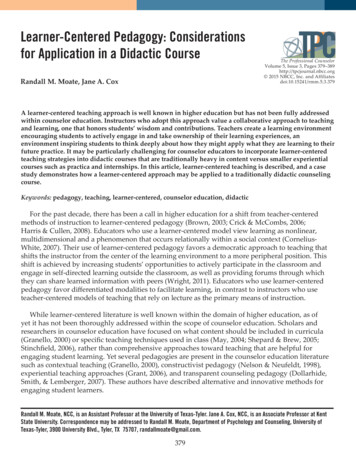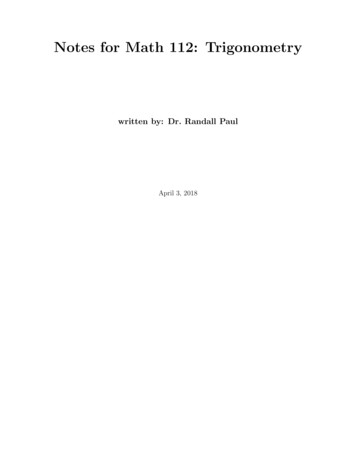
Transcription
Notes for Math 112: Trigonometrywritten by: Dr. Randall PaulApril 3, 2018
c March 2015 Randall PaulThis work is licensed under the Creative Commons Attribution-NonCommercial-ShareAlike 3.0Unported License. The essence of the license is thatYou are free: to Share to copy, distribute and transmit the work to Remix to adapt the workUnder the following conditions: Attribution You must attribute the work in the manner specified by the author (butnot in any way that suggests that they endorse you or your use of the work). Pleasecontact the author at gregg.waterman@oit.edu to determine how best to make anyattribution. Noncommercial You may not use this work for commercial purposes. Share Alike If you alter, transform, or build upon this work, you may distribute theresulting work only under the same or similar license to this one.With the understanding that: Waiver Any of the above conditions can be waived if you get permission from thecopyright holder. Public Domain Where the work or any of its elements is in the public domain underapplicable law, that status is in no way affected by the license. Other Rights In no way are any of the following rights affected by the license: Your fair dealing or fair use rights, or other applicable copyright exceptions andlimitations; The author’s moral rights; Rights other persons may have either in the work itself or in how the work is used,such as publicity or privacy rights. Notice For any reuse or distribution, you must make clear to others the license termsof this work. The best way to do this is with a link to the web page below.To view a full copy of this license, visit http://creativecommons.org/licenses/by-nc-sa/3.0/ or senda letter to Creative Commons, 444 Castro Street, Suite 900, Mountain View, California, 94041,USA.
Contents1 Angles1.1 Degrees and Radians . . .1.1.1 Co-terminal Angles1.1.2 Practice . . . . . .1.2 Radian Formulas . . . . .1.2.1 Arc-length . . . . .1.2.2 Angular Speed . .1.2.3 Sector Area . . . .1.2.4 Practice . . . . . .2 Trigonometric Functions2.1 Acute Angles . . . . . . . . . . . . . . . . . .2.1.1 Practice . . . . . . . . . . . . . . . . .2.2 Unit Circle . . . . . . . . . . . . . . . . . . . .2.2.1 Reference Angle . . . . . . . . . . . . .2.2.2 Definition of the Other Trig Functions2.2.3 Pythagorean Identities . . . . . . . . .2.2.4 Practice . . . . . . . . . . . . . . . . .2.3 Graphs of Sine and Cosine . . . . . . . . . . .2.3.1 Amplitude and Period . . . . . . . . .2.3.2 Phase Shift and Vertical Shift . . . . .2.3.3 Practice . . . . . . . . . . . . . . . . .2.4 Other Trig Graphs . . . . . . . . . . . . . . .2.4.1 Practice . . . . . . . . . . . . . . . . .2.5 Inverse Trig Functions . . . . . . . . . . . . .2.5.1 Inverse Function Review . . . . . . . .2.5.2 Inverse Sine . . . . . . . . . . . . . . .2.5.3 Inverse Cosine . . . . . . . . . . . . . .2.5.4 Inverse Tangent . . . . . . . . . . . . .2.5.5 Inverse Applications . . . . . . . . . .2.5.6 Practice . . . . . . . . . . . . . . . . .2.6 Trigonometric Equations . . . . . . . . . . . .2.6.1 Simple Trigonometric Equations . . . .2.6.2 More Complicated Trig Equations . . .2.6.3 Practice . . . . . . . . . . . . . . . . 4666971727477778084
3 Formulas3.1 Identities . . . . . . . . . . . . . . . . . . . . . . . . .3.1.1 Practice . . . . . . . . . . . . . . . . . . . . .3.2 Sum and Difference Formulas . . . . . . . . . . . . .3.2.1 Writing a Sum as a Single Function . . . . . .3.2.2 Practice . . . . . . . . . . . . . . . . . . . . .3.3 More Trig Formulas . . . . . . . . . . . . . . . . . . .3.3.1 Product-to-sum and Sum-to-product Formulas3.3.2 Double Angle Formulas . . . . . . . . . . . . .3.3.3 Half Angle Formulas . . . . . . . . . . . . . .3.3.4 Practice . . . . . . . . . . . . . . . . . . . . .3.4 Complex Numbers . . . . . . . . . . . . . . . . . . .3.4.1 Trigonometric Form . . . . . . . . . . . . . . .3.4.2 Product, Quotient, and Power . . . . . . . . .3.4.3 Roots . . . . . . . . . . . . . . . . . . . . . .3.4.4 Practice . . . . . . . . . . . . . . . . . . . . .4 Trigonometric Geometry4.1 Law of Sines . . . . . . . . .4.1.1 Ambiguous Case . .4.1.2 Practice . . . . . . .4.2 Law of Cosines . . . . . . .4.2.1 Triangle Area . . . .4.2.2 Practice . . . . . . .4.3 Vectors . . . . . . . . . . . .4.3.1 Trigonometric Form .4.3.2 Static Equilibrium .4.3.3 Practice . . . . . . .4.4 Dot Product . . . . . . . . .4.4.1 Practice . . . . . . 121125126131132133135139141142145
Chapter 1AnglesAngles measure “turning”. Counterclockwise turns are described by positive angles, andclockwise turns negative angles.Angles are described as a rotation taking one ray (called the ‘initial side’) to another ray(called the ‘terminal side’).Example 1.1: A positive angle θ.Example 1.2: A negative angle iniNotice that, though they have the same initial and terminal sides, θ and φ are differentangles.Definition: An angle is in standard position if its initial side is along thepositive x-axis.Example 1.3: Below is the angle θ from example 1.1 in standard position.(Same rotation, different initial and terminal sides.)inaltermθsideinitial side5
The x and y axes divide the plane into four quadrants. If an angle is in standardposition, then its terminal side determines what quadrant the angle is in. For instance θfrom example 1.3 is in quadrant II.1.1Quadrant IIQuadrant IQuadrant IIIQuadrant IVDegrees and RadiansThere are two main units used to measure angles. In degrees a single, complete, counterclockwise rotation is 360 . In radians it is 2π.θ 360 2π (radians)Thus a positive one quarter rotation would be: 14 360 90 14 2π While a backwards one half rotation would be: 12 360 180 90 π2 180 π6π21 2 2π π
Draw the following angles in standard position.5π2 135 3 (radians)When changing from degrees to radians or vice versa just remember that degrees/360 isthe same fraction of a circle as radians/2π. So if an angle is x degrees and y radians, then:yx 360 2πSolving we have the formulas:x 180 yπandy πx 180 Example 1.4: What is 45 in radians?y π45 180 Example 1.5: What is3π2in degrees?x Example 1.6: Approximately what is 1 radian in degrees?Solution:x 180 1 57.3 π7
1.1.1Co-terminal AnglesDefinition: Two angles are said to be co-terminal if, when in standardposition, they have the same terminal side.Example 1.7: The three angles below are co-terminal.If measured in degrees then the angles θ and φ are co-terminal if and only if:θ φ 360 nfor some integer n.If measured in radians then the angles θ and φ are co-terminal if and only if:θ φ 2πnfor some integer n.Example 1.8: Write three positive angles and three negative angles coterminal to 110 .Solution:110 0 110 110 360 470 110 2 · 360 830 110 360 250 110 2 · 360 610 110 3 · 360 970 8
Example 1.9: Write three positive angles and three negative angles coterminal to 7π.6Notice we can also tell if two given angles are co-terminal since we know φ and θ areco-terminal if and only if φ θ 360 n (or 2πn if in radians).Example 1.10: Determine which, if any, of the angles below are co-terminal.220 , 600 , 500 Solution:220 600 380 6 360 n so 220 and 600 are not co-terminal.What about the others?9
1.1.2PracticePractice Problems (with solutions)1. Draw the following angles (the turnings, not just the terminal side).(a)2π3(b) 3π4(c)19π82. Convert the following angles measuredin degrees to angles measured in radians.(a) 225 (b) 150 (c) 630 3. Convert the following angles measuredin radians to angles measured in degrees.(a)3π4(b) 7π64. The measure of an angle in standardposition is given. Find two positive andtwo negative angles that are co-terminalto the given angle.5. Determine whether the angles are coterminal.(a) 50 and 770 .(b) 40 and 320 .(c) 150 and 440 .(d)(c) 8(b) 7π3(a) 80 17π3and29π.3Homework 1.11. Draw the following angles (the turnings, not just the terminal side).(a)(b)(c)(d)3π24π35π413π3(e) π8(f)(g)(h)3π813π823π8(a) 50 2. Convert the following angles measuredin degrees to angles measured in radians.(a) 135 (b) 400 3π8(b)25π6(b)3π4(b) 30 and 330 .(c)17π6and5π.6(d)32π3and11π.3(e) 155 and 875 .(c) 1610(c) π65. Determine whether the angles are coterminal.(a) 70 and 430 .(c) 250 3. Convert the following angles measuredin radians to angles measured in degrees.(a)4. The measure of an angle in standardposition is given. Find two positive andtwo negative angles that are co-terminalto the given angle.
Practice Solutions:3. (a)3π·41. (a) Divide π into thirds. 180 π 540 π 135 4π(b)2π3 1260 π7π 180 210 ·6π6π(c)8·(b) Divide π into quarters 180 π 1440 458.4 π4. (a) Positive:80 1 · 360 440 80 5 · 360 1880 Negative: 3π480 1 · 360 280 80 7 · 360 2440 (b) Positive:6ππ7π 1· 333Oops! Still negative.6π5π7π 2· 3336π77π7π 14 · 333Negative:7π6ππ 1· 3337π6π67π 10 · 333 5. (a) 50 770 720 2(360 ),so yes, coterminal(b) 40 320 360 1(360 ),so yes, coterminal(c) 150 440 590 6 k(360 ),so no, not coterminal(d)17π 29π12π · 4π 2(2π)333so yes, coterminal(c) Divide π into eighths.19π16 3 88819π82. (a)225 ·(b) 150 ·(c) π 225 π5π 1801804 π 150 π5π 1801806630 · π 630 π7π 180180211
1.2Radian FormulasDegrees are the oldest way to measure angles, but in many ways radians are the better wayto measure angles. Many formulas from calculus assume that all angles are given in radians(and this is important).The formulas below also assume angles are given in radians.1.2.1Arc-lengthIn general the arc-length is the distance along a curving path. In this class we only considerthe distance along a circular path.sIf we consider the fraction of the circleswept out by the angle θ and recall the circumference of a circle is 2πr, then we haverθsθ 2π2πrrwhich we solve to get theArc-length Formula.s θr(θ in radians)Example 1.11: Find the length of the arc on a circle of radius 18 cm subtended by the an angle of 100 .s ?100 18cm12
Example 1.12: The distance from the Earth to the Sun is approximatelyone hundred fifty million kilometers (1.5 108 km). Assuming a circular orbit,how far does the Earth move in four months?1.2.2Angular SpeedEveryone remembers the old formula for speed:speed distancetimeWhen we talk about circular motion there are two kinds of speed:linear speed (denoted v) and angular speed (denoted ω).linear speed v arc lengthtimeangular speed ω angletimeIf we take the arc-length formula and divide both sides by time,s θr sθ rttwe get the Angular Speed Formulav ωr(ω inradians)time13
Example 1.13: A merry-go-round is ten meters across and spinning at arate of 1.5 rpm (rotations per minute). What is the angular speed (in radians/minute) of a child on a horse at the edge of the merry-go-round? What isthe linear speed (in kilometers/hour) of the child?Solution: The angular speed is 1.5 rpm. To put it into the appropriate units:ω 1.5radiansrotations 2π radians· 3πminuterotationminuteThe linear speed simply uses the Angular Speed Formula:v ωr 3πmeters· 5 meters 15πminuteminuteNote ‘radians’ is a dimensionless unit and so may be dropped. We need onlychange linear speed to the appropriate units.v 15πmeters kilometer 60 minuteskilometers·· 2.83minute 1000 metershourhourExample 1.14: What is the linear speed of the Earth (in km/hr)?(Hint: Use example 1.12)14
1.2.3Sector AreaAs well as discussing the length of an arc subtended by an angle, we may also talk aboutthe area of the wedge subtended by an angle. This is called the Sector Area (denoted A).If we consider the fraction of the circleswept out by the angle θ and recall the areaof a circle is πr 2 , then we haveArθθA 22ππrrwhich we solve to get theSector Area Formula.A 12 θr 2(θ in radians)Example 1.15: A wedge-shaped slice of pizza has an area of 60cm2 . The endof the slice makes an angle of 35 . What was the diameter of the pizza fromwhich the slice was taken?15
1.2.4PracticePractice Problems (with solutions)1. Find the length of the arc s in the figure.s135 5. A fan on “slow” turns at 25 rotationsper minute. The blades extend 18inches from the center.(a) What is the angular speed of thefan in rad/min?4m(b) What is the linear speed of thetips of the blades (in inches perminute)?2. Find the angle θ in the figure (in degrees).30 cmθ6. Two rollers are connected by a leatherbelt which is tight and does not slip.The right roller is 25 cm in radius andspinning at 6 rotations per second. Theleft roller is 20 cm in radius.(a) Find the angular speed of the rightroller (in radians per second).8 cm(b) Find the linear speed of the belt(in cm per second).3. Quito, Ecuador and Libreville, Gabonboth lie on the Earth’s equator. Thelongitude of Quito is 78.5 West, whilethe longitude of Libreville is 9.5 East.(The radius of the Earth is 3960 miles.)Find the distance between the twocities.4. Find the area of the sector shown in thefigure below.A120 6 ft16(c) Find the angular speed of the leftroller (in radians per second).2025
Homework 1.21. Find the length of the arc s in the figure.s5m140 2. Find the angle θ in the figure (in degrees).10 cm5. The Greek mathematician Eratosthenes (ca. 276-195 B.C.E) measuredthe radius of the Earth from the following observations. He noticed that on acertain day at noon the sun shown directly down a deep well in Syene (modern Aswan, Egypt). At the same time500 miles north on the same meridian inAlexandria the sun’s rays shown at anangle of 7.2 with the zenith (as measured by the shadow of a vertical stick).Use this information (and the figure) tocalculate the radius of the Earth.500θ5 cmSun7.2 AlexandriaSyene3. Find the radius r of the circle in thefigure.8 ft6. Find the area of the sector shown in thefigure below.8mA80 2 radr4. Pittsburgh, PA and Miami, FL lie approximately on the same meridian (theyhave the same longitude). Pittsburghhas a latitude of 40.5 N and Miami25.5 N. (The radius of the Earth is3960 miles.)Find the distance between the twocities.178m7. A ceiling fan with 16 inch blades rotatesat 45 rpm.(a) What is the angular speed of thefan (in rad/min)?(b) What is the linear speed of the tipsof the blades (in inches per second)?
8. The Earth rotates about its axis onceevery 23 hours, 56 minutes, and 4 seconds. The radius of the Earth is 3960miles.What is the linear speed of a point onthe Earth’s equator (in miles per hour)?(b) Find the angular speed of thewheel sprocket (in radians perminute).(c) Find the speed of the bicycle (inmiles per hour).9. The sprockets and chain of a bicycleare shown in the figure. The pedalsprocket has a radius of 5 inches, thewheel sprocket a radius of 2 inches, andthe wheel a radius of 13 inches. Thecyclist pedals at 40 rpm.1352(a) Find the linear speed of the chain(in inches per minute).Practice Solutions:1. π 3π 135 ·180 4 3πs θr 4 m 3π m 9.4248 m411A θr 2 22 2. θ 1.536 radiansd θr (1.536)(3896 mi) 6082 mi4.120 · π 2π 180 3 (6 ft)2 12π ft25. (a)θ 3. Quito is west of the Prime Meridian (0 Longitude), while Libreville is east, sowe add the longitudes. π 88 π θ (78.5 9.5 ) ·180 180 2π3 A 37.7 ft2ω 30 cm 3.75 radians8 cm 675 180 214.9 θ 3.75 ·ππ 25 rotations2π radians·minuterotation ω 50πradiansminute(b)v v 900π 50π radians· 18 inchesminuteinchesinches 2827.4minuteminute6. (a)ωR 2π radians6 rotations·secondrotation ωR 12π18radianssecond
(b) The linear speed of the belt is thesame as the linear speed of a pointon the right roller. 12π radiansv · 25 cmsecond v 300πcmcm 942.5secsec(c) The linear speed of the belt is alsothe same as the linear speed of apoint on the left roller.ωL 942.5 cm/secv r20 cm ωL 47.119radsec
20
Chapter 2Trigonometric FunctionsNow that we understand about angles we move on to the most important subject in thisclass—functions whose domain consists of angles. That is, functions which take an angleand return a real number. The ones we care about are called the trigonometric functions,and there are six of them: sine, cosine, tangent, cotangent, secant, and cosecant. In the nextsections we will define these functions and discuss their properties.2.1Acute AnglesThe trigonometric functions are defined for almost all angles from minus infinity to plusinfinity. However their values are particularly easy to understand when applied to acuteangles (angles between 0 and 90 ). Acute angles are characterized by being an interiorangle of a right triangle.Say θ is an acute angle. Then θ is an interior angle in a right triangle, and we may definethe six trigonometric functions as follows:pohyeusnteoppositesin θ oppositehypotenusesec θ hypotenuseadjacentcos θ adjacenthypotenusecsc θ hypotenuseoppositetan θ oppositeadjacentcot θ adjacentoppositeθadjacentExample 2.1:53θ4sin θ 35sec θ cos θ 45csc θ tan θ 21cot θ
Some people remember the first three definitions with the acronym: SOHCAHTOAfor “Sine is Opposite over Hypotenuse, Cosine is Adjacent over Hypotenuse, and Tangent isOpposite over Adjacent.You might fear that this definition of the trigonometric functions will depend on the sizeof the triangle. It does not. Below is a triangle similar to the triangle in example 2.1.Example 2.2:Note that still106θcos θ 84 105tan θ 36 104etc.8We now introduce two special right triangles whose angles and sides are known exactly.The 45 45 90 Triangle: 21 π42π41π4π41 121The 30 60 90 Triangle:1 32 1π61 32π3121Example 2.3: Evaluate the trig functions:sin(60 ) tanπ3cosπ4secπ6 3/21 1 32 22 12
Using the values of the trigonometric functions for π/6, π/4, and π/3, we may solve forthe sides of any triangle which has one of these angles in it (if one side is known).Example 2.4: Use the exact values of appropriate trig functions to find thesides b and h in the triangle below.hSolution: We want to know b, theside opposite to π/3, and we alreadyknow that the side adjacent to π/3is 5, so we use the tangent (oppositeover adjacent). Thus,bπ35tanπ3 b53 b5 b 5 3To find h. . . ?Example 2.5: A 15 foot long ladder is leaned against a wall so that the laddermakes a 60 angle with the floor. Use a trigonometric function to determinehow high up the wall the ladder reaches. (Be sure to draw a picture.)For angles other than 30 , 45 , or 60 we cannot (usually) find an exact value for thetrigonometric functions. However using a calculator, we may approximate the sides of anyright triangle where an angle and one of the sides is known.23
Example 2.6: Use a trig function and your calculator to approximate thevalue of the unknown sides.We want the adjacent, a, and weknow the hypotenuse, 63.63b41 acos(41 ) a630.7547 a63 a 63(0.7547) 47.55To find b. . . ?Example 2.7: When the sun is 50 above the horizon a tree casts a shadowthat is 20 meters long. Use a trigonometric function and your calculator toestimate the height of the tree. (Be sure to draw a picture.)24
2.1.1PracticePractice Problems (with solutions)1. For the triangle below, evaluate thetrigonometric functions.(Do not simply.)3π82π/8p 2 2p2 3. Use a trig function and your calculator to approximate the value of the unknown sides.2h(a) cos(π/8)(a)(b) tan(3π/8)957 a(c) csc(π/8)2. Use a trig function to find the exactvalue of the unknown sides.50π68(a)(b)bp34 aa4. From the top of a 20 meter high castlewall, the angle of depression to a knightin the field is 16 . The knight rides directly toward the wall until the angle ofdepression is 50 .How far did the knight ride?(Be sure to draw a picture.)π4h12(b)a25
Homework 2.11. Use a trig function to find the exactvalue of the unknown sides.h4. A man is lying on the ground, flying akite. He holds the end of the kite stringat ground level, and estimates the angleof elevation to be 40 .If the string is 200 meters long, howhigh is the kite?10π3(a)aπ4hp(b)202. Use a trig function and your calculator to approximate the value of the unknown sides.h(a)(b)5. A flagpole is 50 meters from a schoolbuilding. From a window in the schoolthe angle of elevation to the top of theflagpole is 35 , while the angle of depression to the base of the flagpole is25 .How tall is the flagpole?6. The method of parallax can be usedto calculate the distance to near-bystars. A not too distant star will apparently move (slightly) as the Earthgoes around the Sun. For instance overa six month period the binary star αCentauri appears to shift .000422 inthe sky.Given that the Sun is about 1.5 108kilometers from the Earth, how far isα-Centauri from the Sun?(See figure)1253 ah3. From the top of a 100 meter high lighthouse the angle of depression to a shipin the ocean is 28 .How far is the ship from the base of thelighthouse? (Be sure to draw a picture.)pEarth (Winter)38 .000422 500Sunα-CentauriEarth (Summer)26
Practice Solutions:h sin(57 ) 91. (a)cos π tan 8p 2 2 2 h (b)3π8 (c)csc π 82. (a)p p p2 2 22 tan(57 ) 2(b)sin(34 ) 3b cos682! 3 b 8 4 32 π a1 sin682 1 a 8 42cos(34 ) 4a50 a 50 cos(34 ) 41.4516 20 m p50 p 50 sin(34 ) 27.96(b) π 9 5.84tan(57 )2 π cos9aa tan(57 ) 92 a 9 10.73sin(57 ) 212 h250 4.d2 2424 h 2 h 12 22 π atan 1412 a 123. (a)tan(90 16 ) d1 69.75 mtan(90 50 ) d1d120d220 d2 16.78 m9sin(57 ) hdistance d1 d2 53.0 m27
2.2Unit CircleThe definition of the trigonometric functions for general angles (not just acute angles) involves the unit circle. What is the unit circle, you say? It’s the circle, centered at theorigin, with radius one.Alternatively it’s the set of all points (x, y) which satisfy the equation: x2 y 2 1.y(1, 1) 23 , 1212 02 1(1, 0)x 2 23 1 22 112 12 2 6 1We now define sine and cosine for any angle. The other four trigonometric functions willbe defined in terms of sine and cosine.yDraw the angle θ in standard position.Consider the point p where the terminal sideof θ crossed the unit circle.The x coordinate of p is cos θ.The y coordinate of p is sin θ.p (cos θ, sin θ)θExample 2.8: Find the cosine and sine of 90 .y(0, 1)90 p (0, 1)xcos(90 ) 0sin(90 ) 128x
Example 2.9: Draw the angle and find the cosine and sine of 180 .yp xcos( 180 ) sin( 180 ) Example 2.10: Draw the angle and find the cosine and sine ofy7π.2p xcos7π2sin7π2 Now that we basically understand sine and cosine, let’s ask some basic questions.What is the domain of sine (and cosine)? The definition makes sense for any angle, soDomain(sin) Domain(cos) ( , )What is the range of sine (and cosine)?The output for either function is a big as 1 and as small as 1 with all numbers inbetween, soRange(sin) Range(cos) [ 1, 1]Example 2.11: Say θ is an angle in the second quadrant with the properties:cos θ 53 and sin θ 45 .What quadrant is θ π in? What is the cosine and sine of θ π?yθ π is in quadrant IV. 53 , 54The two triangles are congruent.Therefore,θ xp 53 , 45θ πpcos(θ π) 35sin(θ π) 5429
Example 2.12: Say θ is as in example 2.11. What quadrant is θ in?Draw the angle and find the cosine and sine of θ.y θ is in Quad 53 , 54θp xcos( θ) sin( θ) There are a couple of important things to be learned from examples 2.11 and 2.12.First, cosine is positive when the x coordinate is positive—that is in quadrants I and IV.Sine is positive when the y coordinate is positive—in quadrants I and II. Tangent will bedefined to be the sine divided by the cosine. Therefore tangent is positive when both sineand cosine are positive or both negative—quadrants I and III.This important information is encapsulated in the following diagram and mnemonic.“All Students Take Calculus”Sine positiveTangent positiveAll positiveCosine positiveSecond, cos( θ) cos(θ) while sin( θ) sin(θ). This means cosine is an evenfunction, while sine is an odd function. We will have more to say about this in the nextsection.We now consider the cosine and sine of certain special angles.Example 2.13: Use one of the special triangles to find the cosine and sine of3π.4ypThe triangle pqo is 45 45 90 .Therefore,3π π44 1 , 1p x22oqcos( 3π) 124sin( 3π) 430 12
Example 2.14: Find the quadrant and draw the angle 60 .Draw the appropriate special triangle and find the cosine and sine of 60 .yp xcos ( 60 ) sin ( 60 ) Example 2.15: Find the quadrant and draw the angle 7π.6Draw the appropriate special triangle and find the cosine and sine ofy7π.6p x2.2.1cos7π6sin7π6 Reference AngleDefinition: The reference angle to an angle, θ in standard position, is thesmallest positive angle between the terminal side of θ and the x-axis.From example 2.13 we see that reference angle for 3πis π4 .4From example 2.14 we see that reference angle for 60 is 60 .From example 2.15 we see that reference angle for 7πis π6 .6 Note the reference angle is always between 0 and 90 .31
Example 2.17: What is the referenceangle for 17π?3yExample 2.16: What is the referenceangle for 5π?6yxxThe reason we care about the reference angle is that the cosine (or sine) of any angle isplus or minus the cosine (or sine) of its reference angle. You figure out the plus or minusbased on the quadrant.Example 2.18: Find the cosine and sine ofSolution: 5πis in quadrant II.6By example 2.16 the reference angle forThus, π 35π cos cos6625π65π.6is π6 .(since cosine is negative in quadrant II). 5π sin6Example 2.19: Find the cosine and sine of17π.3Notice on example 2.19 the very handy fact that, since sine and cosine only depend onthe terminal side, co-terminalhave the same sine and cosine. angles17π5π17πThus, cos 3 cos 3 since 3 and 5πare co-terminal angles.332
2.2.2Definition of the Other Trig FunctionsThe other trigonometric functions are defined in terms of cosine and sine, so once you knowthese functions you know all six trig functions.tan θ sin θcos θsec θ 1cos θcot θ cos θsin θcsc θ 1sin θExample 2.20: Find the tangent of 3π.4Solution: sin 3π1/ 23π4 1 tan4cos 3π 1/24Example 2.21: Find the secant of5π.6Example 2.22: Find the cotangent of2.2.37π.6Pythagorean IdentitiesDefinition: Identities are equations that are satisfied by any legal value ofthe variable.We’ll discuss identities in-depth in section 3.1, but for now we only consider three important identities.33
Recall that the cosine and sine are the x and y coordinates of a point on the unit circle.yp (cos θ, sin θ)The equation of the unit circle isx2 y 2 1θxSubstituting x cos θ and y sin θ,cos2 θ sin2 θ 1This is the first Pythagorean Identity.Notation: (sin θ)2 is usually written without the parentheses as sin2 θ. This can be donefor any trig function.The second and third Pythagorean Identities are found by dividing the first by cos2 θ orsin2 θ.cos2 θ sin2 θ1 22sin θ sin θsin2 θcos2 θ sin2 θ1 cos2 θ cos2 θcos2 θgives 1 tan2 θ sec2 θgives cot2 θ 1 csc2 θExample 2.23: Say θ is in Quadrant II, and sin θ 23 .Find the five remaining trig functions of θ.Solution: We find cos θ by substituting into the first Pythagorean identity. 2cos2 θ 32 1q cos θ 1 49 53(Negative since cosine is negative in quadrant II.)The other four we find by using their definitions: 2/352 5/3 tan θ cot θ 2/32 5/35sec θ 13 5/35csc θ 3413 2/32
5.Example 2.24: Say θ is in Quadrant II, and cos θ 13Find the five remaining trig functions of θ.Example 2.25: Say θ is in Quadrant III, and tan θ 57 .First find sec θ, then find the four remaining trig functions of θ.35
2.2.4PracticePractice Problems (with solutions)For the following angles use thetriangle:1. Determine if the following points are onthe unit circle.(a) ( 8/17, 15/17)(b) (5/8, 3/8)π/51(142. For each of the following angles:i. Sketch the angle on the unit circle.ii. State and sketch the reference angle.iii. Clearly use the reference angle tofind the cosine and sine of the angle.(a)5π33π101(b) 3π4(c) 4π514 p 10 2 55)(d) π53. Say θ is in Quadrant IV, and cos θ 34 .Find the sine, secant, tangent, cosecant,and cotangent of θ.4. Say θ is in Quadrant III, and tan θ 78 .Find the sine, cosine, secant, cosecant,and tangent of θ.Homework 2.2(Note: These problems should be done without the use of a calculator.)1. Say whether or not the following pointsare on the unit circle, and show how youknow.(a)3 4,5 5(b)1 1,2 2 3π2(b)4π3(c)5π4(d)p 2 2(a) π8 (b)2. Draw the angle on the unit circle andfind the cosine and sine for each of theangles below. (See homework 1.1 problem 1)(a)π/812 5(c) 13, 1213 (d) 37 , 32 13π3(b)363π8(c)12p 2 213π8(d)23π84. F
1.1 Degrees and Radians There are two main units used to measure angles. In degrees a single, complete, counter-clockwise rotation is 360 . In radians it is 2π. θ 360 2π (radians) Thus a positive one quarter rotation would be: 1 4 360 90 1 4 2π π 2 While a backwards one half rotation would be: 1 2 360 180 1 2 2π π




